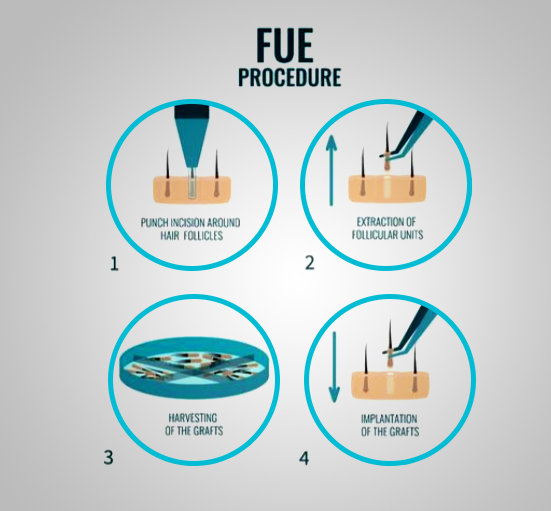- Are you planning for a hair transplant in Jaipur?
- Do you know the difference between two types of hair transplant techniques, namely, FUT and FUE?
Here, we will discuss these hair transplant methods and know how they are similar or different.
First, let us know,
What is a Hair Transplant?
A hair transplant surgeon extracts your hair from the donor area and implants them into the recipient or bald region. This donor area is generally the area from the back of your scalp. The grafts are removed from this donor area either by the FUT or FUE hair transplant technique.

What is FUT Hair Transplantation?
In the FUT, the surgeon removes a thin strip of 4 to 6 inches. Then, divides the strip into 500 to 2000 hair grafts. The number of hair grafts required depends on the hair type, quality, and donor region availability.

What is FUE Hair Transplantation?
FUE is a relatively recent and advanced hair transplant process. Here, the hair transplant surgeon doesn’t make strips, preferably extracts individual follicles. The entire scalp is shaved off before the process, and then the hair grafts are individually extracted.
How is Graft Extraction done?
Remember, one of the most critical factors for hair transplantation is the extraction method. Here, the focus is on the quality of hair grafts rather than quantity.
The surgeons use a punch needle to remove hair grafts in the FUE method. It ensures minimal damage to the donor area. A well-qualified and experienced surgeon who provides the best hair transplant must perform this surgery. Therefore, you must select the right hair transplant surgeon.
It is crucial to extract the grafts precisely in the FUE procedure. Therefore, surgeons use high-quality instrumentation such as punch tools. Their punches are fine and accurate. They ensure a clear cut and minimal damage and scarring. It is necessary to safely store these hair grafts since they are very delicate and may dehydrate quickly.
In the FUE, the yield of the hair grafts and their survival tends to reduce. The survival rate of the follicles is more in the FUT method. If these follicles aren’t handled correctly in either procedure, it can damage the hair follicles. The chances of the grafts getting damage in the FUT are less.
What happens after the Graft Extraction?
After the grafts are extracted, the steps of both methods are more or less similar. The hair transplant surgeon cleans the scalp, numbs the area, and creates slits on the scalp with a needle or scalpel. Then transplants the hair graft into each slit. Generally, one single hair graft has two to four hair.
The duration and number of grafts required in the FUE method depend on the transplant area’s size. Typically, one needs about 1000 to 5000 follicular units, and the procedure takes about 8 hours at least.
What to expect after the Hair Transplant?
Both these hair transplant procedures are done under local anaesthesia. Hence, patients don’t feel any pain during the process. However, after the FUT process, patients may experience some tension on their scalp, but it fades away gradually.
After the procedure, the scalp is generally susceptible. Patients experience slight pain in the scalp as the anaesthesia starts to wear off. The hair transplant surgeon may prescribe specific medicines to manage the pain.
Two to three weeks after the transplant, new hair begins to grow and shed. However, don’t worry; it is part of the natural healing process. Within 6 to 9 months, new hair starts to grow.
What is the recovery time?
The healing time for the FUE process is quicker than for FUT. The pain experienced during the FUE process is almost close to no pain. Patients may feel slight numbness during the FUT procedure, which one doesn’t feel during the FUE procedure. Patients will face swelling after both methods, which will reduce in 6 to 8 days.
How much is the risk of developing scars?
What makes FUE different from FUT is also the extent of scarring. Both these methods cause some or the other scarring. FUT makes a linear scar due to the removal of a strip. On the other hand, the FUE method creates small circular spots, which are not very noticeable. However, this differs from person to person.
Now, let’s know,
Advantages of the FUE over FUT method
- No cuts and stitches as in FUT hence preferred for a body hair transplant
- Quicker recovery compared to FUT
- No linear scars as in FUT
- Availability of more donor area as we can use hairs of other body areas, such as the beard, chest for transplant
Looking at all these significant advantages, FUE is known to be very effective.
Now let’s also discuss,
Disadvantages of FUE over FUT method:
- FUE is very time-consuming than FUT.
- The risk of damaging the hair grafts is higher than FUT.
- The survival rate of grafts is more in FUT.
- Compared to FUT, the FUE technique is an extremely delicate and skillful job.
- Inexperienced hair transplant surgeons or under-equipped clinics can damage the hair grafts. Hence, FUE requires technical skills and expertise, which can be disadvantageous, resulting in a higher hair transplant cost in Jaipur.
Remember, for a successful hair transplant, selecting the proper extraction technique is very important. Be it the FUT or FUE procedure, a hair transplant’s success depends on certain other factors, such as the surgeon’s experience, skills, and training. No matter which method you go for, getting it done by an experienced surgeon should be at the top of your priorities.
Which procedure is suitable for you is something you should discuss with your hair transplant expert. Your surgeon will examine your scalp, existing hair quality, and density. Then, evaluate your donor to recipient ratio, prescribe some general tests, and suggest a suitable extraction method.
Therefore, you need to make a well-informed decision for your hair transplant. Discuss your expectations clearly and frankly with your surgeon. Talk to your surgeon about what procedure will suit you, the hair transplant cost, recovery, etc. Only then decide to go for a hair transplant and choose the correct extraction method for you.

